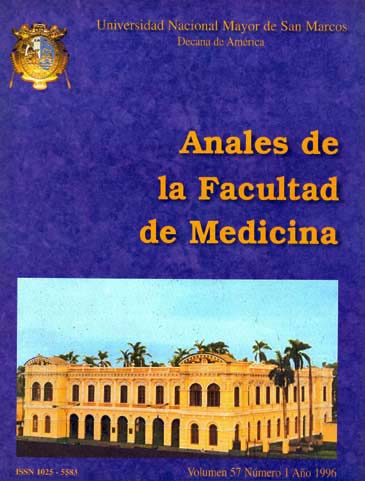Testosterone and testosterone plus 17 beta-estradiol prostatic hyperplasia induced in castrated rats
DOI:
https://doi.org/10.15381/anales.v57i1.4747Keywords:
Benign prostatic hyperplasia, testosterone, estradiolAbstract
Begin prostatic hyperplasia etiology is still unknow. It is believed that estradiol (E2) is involved. The objetive of this study was to determine the E2 action in the prostatic proloferation induced in castrated rats. The experimental was randomized in 3 independent groups during 4 weeks; the first one, control without treatment; the second one, castrated and testosterone enantate (TE) treated; and the third one, castrated and TE plus 17 beta-estradiol hemisuccinate treated. Weight prostatic difference was studied with the U test, histology with light-microscopy. Weight prostatic difference between the second and third groups as in the significance limit (P=0.05). Histologically increase in secretion and hyperplasia was noted in the third group. We concluded that E2 synergizes testosterone proliferating action upon the prostate and this could account for benign prostatic hyperplasis genesis.Downloads
Published
1996-03-18
Issue
Section
Trabajos originales
License
Copyright (c) 1996 Carlos Gonzáles, Ygna Oyola, Paul Herrera

This work is licensed under a Creative Commons Attribution-NonCommercial-ShareAlike 4.0 International License.
Those authors who have publications with this magazine accept the following terms:
- Authors will retain their copyrights and guarantee the journal the right of first publication of their work, which will be simultaneously subject to Creative Commons Attribution License that allows third parties to share the work as long as its author and its first publication this magazine are indicated.
- Authors may adopt other non-exclusive licensing agreements for the distribution of the version of the published work (eg, deposit it in an institutional electronic file or publish it in a monographic volume) provided that the initial publication in this magazine is indicated.
- Authors are allowed and recommended to disseminate their work over the Internet (eg: in institutional telematic archives or on their website) before and during the submission process, which It can produce interesting exchanges and increase quotes from the published work. (See El efecto del acceso abierto ).
How to Cite
1.
Gonzáles C, Oyola Y, Herrera P. Testosterone and testosterone plus 17 beta-estradiol prostatic hyperplasia induced in castrated rats. An Fac med [Internet]. 1996 Mar. 18 [cited 2024 Aug. 16];57(1):34-8. Available from: https://revistasinvestigacion.unmsm.edu.pe/index.php/anales/article/view/4747















